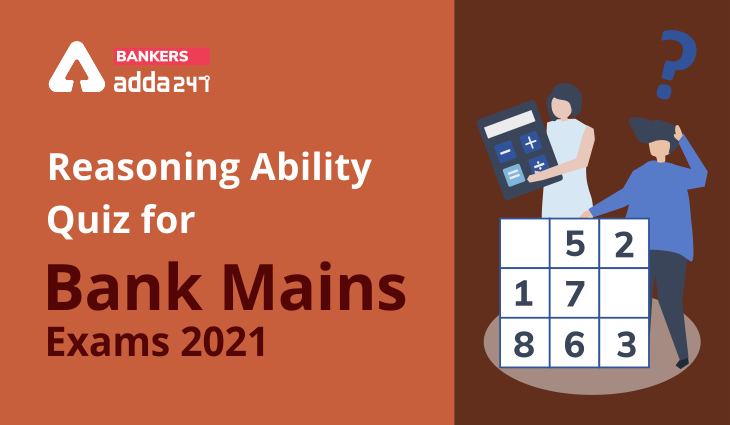Table of Contents
Directions (1-5): Study the following information carefully and answer the given questions:
Eight persons A, B, C, D, E, F, G, and H are seated around a circular table. They all are of different ages- 24, 15, 19, 30, 27, 45, 36 and 10. Four of them are facing towards the center and rest outside the center.
B sits 2nd to the left of A, who is 6 years younger than G. B and A, who is not the youngest face opposite direction. H’s age is a perfect square. The one who is 30years old sits 3rd to the right of B. Both the immediate neighbors of G face the opposite direction of G. F sits 2nd to the right of G. F is not an immediate neighbor of B. The one whose age is perfect cube faces inside and sits opposite to E, who is not an immediate neighbor of F. Not more than 2 persons who sit together face the same direction. H doesn’t sit just near to G. The one who is the oldest faces inside. The difference between the ages of D and C is 5yesrs. The youngest person is not an immediate neighbor of E. Age of E is not a prime number.
Q1. Who among the following is the oldest person?
(a) A
(b) C
(c) B
(d) E
(e) None of these
Q2. Who among the following is 10 years old?
(a) C
(b) A
(c) D
(d) H
(e) Either (a) or (c)
Q3. Who among the following sits opposite to the one who is 15 years old?
(a) H
(b) C
(c) The one whose age is 30
(d) The one whose age is 24
(e) B
Q4. What is the age of F?
(a) 36
(b) 45
(c) 27
(d) 19
(e) 30
Q5. Who among the following sits immediately left of the one who is 19 years old?
(a) B
(b) A
(c) H
(d) G
(e) C
Directions (6-10): In the following questions, the symbols @, #, %, * and $ are used with the following meaning as illustrated below:
‘P @ Q’ means ‘P is not smaller than Q’.
‘P # Q’ means ‘P is not greater than Q’.
‘P % Q’ means ‘P is neither greater than nor equal to Q’.
‘P * Q’ means ‘P is neither smaller than nor greater than Q’.
‘P $ Q’ means ‘P is neither smaller than nor equal to Q’.
Now in each of the following questions assuming the given statements to be true, find which of the three conclusions I, II and III given below them is/are definitely true and give your answer accordingly.
Q6. Statements:
M % O# R # S $ T * N
Conclusions:
I. N * R
II. N $ R
III. S $ M
(a) All follow
(b) Only either I or II follows
(c) Only III follows
(d) Only either I or III and II follows
(e) None of these
Q7. Statements:
J #N *O @M $ T $ K
Conclusions:
I. J % T
II. K % N
III. N @ J
(a) None follows
(b) Only I and II follow
(c) Only I and III follow
(d) Only II and III follow
(e) All follow
Q8. Statements:
B * D $ E @ H * G % F
Conclusions:
I. B $ F
II. D # F
III. D $ F
(a) None follows
(b) Only II follows
(c) Only either II or III follow
(d) Only III follows
(e) All follow
Q9. Statements:
T $ U % K # L * R @ M
Conclusions:
I. M # L
II. R $ U
III. R @ K
(a) All follow
(b) Only either I or III follows
(c) Only either I or II follows
(d) Only either II or III follows
(e) None of these
Q10. Statements:
V @ M *A $ P * R # N
Conclusions:
I. R # A
II. V @ R
III. R $ M
(a) Only I follows
(b) Only II follows
(c) Only III follows
(d) None follows
(e) All follow
Directions (11-15): Study the given information carefully to answer the given question.
In a certain code language,
‘camels dessert in teaching’ is written as ‘ U3H T3.5G Y1M S4T’
‘work mirage water mostly’ is written as ‘W2P U3V V2.5I U3B ’
‘bright thing sun’ is written as ‘U3G V2.5T X1.5M’
‘roller cycles success create’ is written as ‘U3I U3H T3.5H U3V ’
Q11. In the given code language, what does the code ‘V2.5S’ stand for?
(a) crush
(b) rush
(c) thug
(d) prime
(e) None of these
Q12. What is the code for ‘skill’ in the given code language?
(a) V3S
(b) V2.5S
(c) T3.5S
(d) V2S
(e) None of these
Q13. What is the code for ‘garden’ in the given code language?
(a) M5U
(b) U5.5M
(c) U3M
(d) U2M
(e) None of these
Q14. What will be the code for ‘T3.5M’ in the given code language?
(a) Joker
(b) Panther
(c) Grave
(d) Yard
(e) None of these
Q15. What may be the possible code for ‘screwdriver’?
(a) W2.5G
(b) W2V
(c) J2.5V
(d) P5.5I
(e) None of these.
Practice More Questions of Reasoning for Competitive Exams:
Solutions
S1. Ans.(d)
Sol.

S2. Ans.(e)
Sol.

S3. Ans.(d)
Sol.

S4. Ans.(c)
Sol.

S5. Ans.(c)
Sol.

S6. Ans.(c)
Sol. Conclusions:
I. N * R ( Not True )
II. N $ R ( Not True )
III. S $ M ( True )
S7. Ans.(d)
Sol. Conclusions:
I. J % T ( Not True )
II. K % N ( True )
III. N @ J ( True )
S8. Ans.(c)
Sol. Conclusions:
I. B $ F ( Not True )
II. D # F ( Not True )
III. D $ F ( Not True )
S9. Ans.(a)
Sol. Conclusions:
I. M # L ( True )
II. R $ U ( True )
III. R @ K ( True )
S10. Ans.(d)
Sol. Conclusions:
I. R # A ( Not True )
II. V @ R ( Not True )
III. R $ M ( Not True )
S11. Ans.(a)
Sol. First letter of the code is obtained from reversing (A-Z, B-Y…) the alphabet which has the same rank as the total number of alphabets in the word.
For example – Trees->Total number of letters=5=Rank of E, reverse of E is V. So, the first letter of the code=V
The number in the code represents the total number of letters in the word divided by 2.
For example – Trees – total number of letters=5/2= 2.5
The last letter of the code is obtained from reversing (A-Z, B-Y…) the last letter of the word.
Trees→ Reverse of S is H. So, the code for trees is V2.5H
S12. Ans.(e)
Sol. First letter of the code is obtained from reversing (A-Z, B-Y…) the alphabet which has the same rank as the total number of alphabets in the word.
For example – Trees->Total number of letters=5=Rank of E, reverse of E is V. So, the first letter of the code=V
The number in the code represents the total number of letters in the word divided by 2.
For example – Trees – total number of letters=5/2= 2.5
The last letter of the code is obtained from reversing (A-Z, B-Y…) the last letter of the word.
Trees→ Reverse of S is H. So, the code for trees is V2.5H
S13. Ans.(c)
Sol. First letter of the code is obtained from reversing (A-Z, B-Y…) the alphabet which has the same rank as the total number of alphabets in the word.
For example – Trees->Total number of letters=5=Rank of E, reverse of E is V. So, the first letter of the code=V
The number in the code represents the total number of letters in the word divided by 2.
For example – Trees – total number of letters=5/2= 2.5
The last letter of the code is obtained from reversing (A-Z, B-Y…) the last letter of the word.
Trees→ Reverse of S is H. So, the code for trees is V2.5H
S14. Ans.(e)
Sol. First letter of the code is obtained from reversing (A-Z, B-Y…) the alphabet which has the same rank as the total number of alphabets in the word.
For example – Trees->Total number of letters=5=Rank of E, reverse of E is V. So, the first letter of the code=V
The number in the code represents the total number of letters in the word divided by 2.
For example – Trees – total number of letters=5/2= 2.5
The last letter of the code is obtained from reversing (A-Z, B-Y…) the last letter of the word.
Trees→ Reverse of S is H. So, the code for trees is V2.5H
S15. Ans.(d)
Sol. First letter of the code is obtained from reversing (A-Z, B-Y…) the alphabet which has the same rank as the total number of alphabets in the word.
For example – Trees->Total number of letters=5=Rank of E, reverse of E is V. So, the first letter of the code=V
The number in the code represents the total number of letters in the word divided by 2.
For example – Trees – total number of letters=5/2= 2.5
The last letter of the code is obtained from reversing (A-Z, B-Y…) the last letter of the word.
Trees→ Reverse of S is H. So, the code for trees is V2.5H
Practice with Online Test Series for Bank Mains 2021:
Click Here to Register for Bank Exams 2020 Preparation Material




 GA Capsule for SBI Clerk Mains 2025, Dow...
GA Capsule for SBI Clerk Mains 2025, Dow...
 The Hindu Review October 2022: Download ...
The Hindu Review October 2022: Download ...
 Fillers Questions for SBI PO Mains Exam ...
Fillers Questions for SBI PO Mains Exam ...





